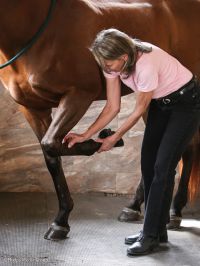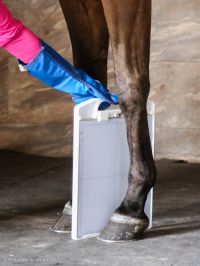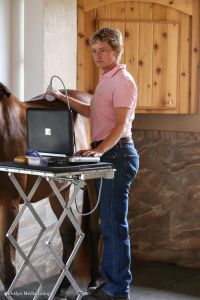
Demystifying the Equine Pre-Purchase Exam
PMG release by: Darlene Ricker
Wellington, FL – March 16, 2015 – It’s an important but little-known fact among horse buyers: All pre-purchase examinations are not created equal.
Pre-purchase exams performed by the DTR Equine Sports Medicine team far exceed the industry norm. In addition to the standard physical and soundness exams, the practice’s veterinarians include extra buyer benefits in their exams. The ability of the horse to perform at the intended level is evaluated by an extensive under saddle assessment in which the horse is observed working at its current level (for example, jumping or executing upper-level dressage movements).
“We like to watch the horse do about half of his normal work routine,” said Dr. Suzan Oakley of DTR Equine. “For a jumper, it doesn’t mean going over a full course. A few fences after a warm up are usually sufficient.”
Before the under saddle evaluation, the DTR team also likes to observe the horse moving on the longeline without gear. “We look to see how the horse wants to move naturally, without side
reins or a rider, ” said Oakley. “This way, any gait abnormalities are clearly seen.”
Oakley believes it is important for a buyer or trainer to come in person to see the horse (and if possible, attend the pre-purchase exam or be available by phone during the exam), rather than buying a horse sight-unseen and solely on the basis of a video or the exam results.
“Personality and suitability of the horse for the rider are important considerations in whether a horse is right for you,” she said. ” I like to see the horse at rest in his stall and observe his demeanor. You also want to see the horse move as comes out of the stall and before he is tacked up. You want to know as much as you can about the whole horse.”
With the use of state-of-the-art diagnostic equipment, a standard pre-purchase exam includes:
- Complete physical exam, including cardiovascular, respiratory, neurologic, ophthalmic and dermatologic systems
- Conformation, biomechanical and musculoskeletal evaluation
- Lameness evaluation on hard and soft ground, including flexion tests
- Evaluation longing and under saddle
- X-rays of front feet, hocks, stifles and fetlocks
Additional x-rays, ultrasound examination of certain structures, blood work and endoscopic exams may also be indicated based on the physical exam. Drug testing is recommended in most cases. A comprehensive report, all images (radiographic and ultrasound) and video clips are also shared with the buyer and his regular veterinarian. Movement exams are video recorded for accurate documentation and provided to the buyer and his home vet.
“We believe that communication with the buyer’s veterinarian is an essential part of the process, as he is most familiar with the client’s needs,” said Dr. Anne Moretta of DTR Equine. A veterinarian who knows the buyer and perhaps some of his previous horses can provide insights that are helpful to the buyer in determining whether the horse is appropriate for him.
In addition, said Oakley, “There can be a lot of emotions involved in buying a horse. Some buyers have already connected emotionally with the horse.” DTR Equine provides an extensive exam to provide as much information as possible for the buyer to make a thorough and objective decision.
While many buyers expect a vet to “pass” or “fail” a horse (as is common in some European nations), that is not the case in the United States. As Moretta explained, pre-purchase exams in this country are designed to provide an overall picture of the horse’s current health, soundness and fitness, and to evaluate existing and potential lameness problems. The practitioners at DTR Equine represent the buyer exclusively and provide the buyer with ‘the facts’ from the pre-purchase exam. The final decision to purchase or decline a sales horse is then made by the buyer. Drs. Oakley and Moretta are available to do pre-purchase exams both in the US and overseas.
About DTR Equine Sports Medicine
DTR Equine Sports Medicine is a team of distinguished equine professionals and educators who offer a proven, scientific, team approach to equine sports medicine. They evaluate the entire horse, beyond symptoms and uncover the root cause of soundness issues with innovative technology. Then, they offer the latest in treatment modalities, inclusive of designing and implementing rehabilitation protocols- a vital step in equine care. They are team-oriented and encourage connecting with your trusted veterinarian and support team to keep your horse performing to its highest capabilities.

Recently Added
- Stall Charts for Pinnacle and L1 Championships Are Available May 6, 2024
- KER Answer Exchange – Yearling Growth May 6, 2024
- Taylor Sheridan’s The Run For A Million Returns to Las Vegas May 6, 2024
- Let’s Talk AQHA Podcast Episode 8- John Pipkin and Dr. Clayton McCook May 6, 2024
- EC Photo of the Day – Mondays Should Be Optional May 6, 2024
- Kyle Dougherty and Slow Southern Drawl win NSBA 3 YO Limited Rider Western Pleasure Futurity May 6, 2024
- Non Pros Lead Off The Madness Futurity Classes May 6, 2024
- Around Churchill Downs – 2024 Kentucky Derby May 5, 2024
- Around the Rings – 2024 Florida Color Horse Club Gator Classic May 5, 2024
- EC Photo of the Day – Cailyn LaBuz and Sleepin N My Blumers May 5, 2024
Archives
Sign In
Equine Chronicle ® All Rights Reserved. Copyright © 2024
4727 NW 80th Ave. • Ocala, FL 34482 • 352 369 1104 • FAX 352 369 1521
Privacy Policy | Questions, please contact The Equine Chronicle
-












